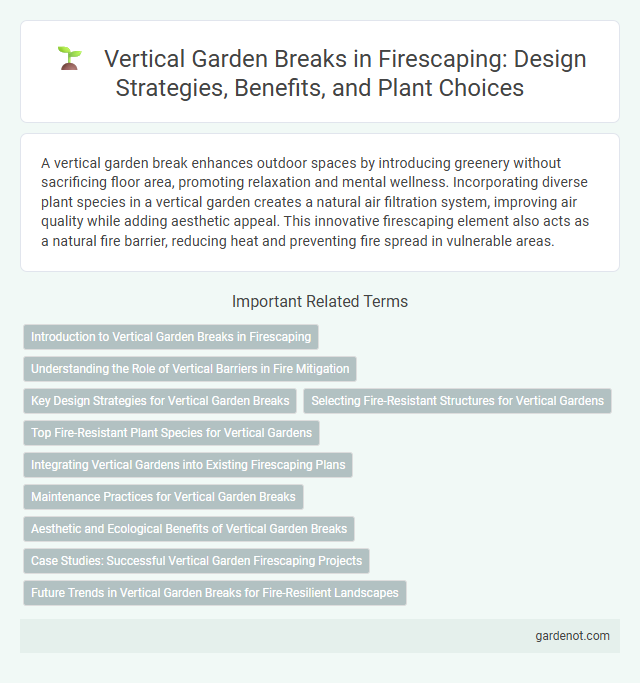A vertical garden break enhances outdoor spaces by introducing greenery without sacrificing floor area, promoting relaxation and mental wellness. Incorporating diverse plant species in a vertical garden creates a natural air filtration system, improving air quality while adding aesthetic appeal. This innovative firescaping element also acts as a natural fire barrier, reducing heat and preventing fire spread in vulnerable areas.
Introduction to Vertical Garden Breaks in Firescaping
Vertical garden breaks serve as strategic fire-resistant barriers within landscape designs, utilizing moisture-rich plants and specialized structures to slow or stop wildfire spread. Incorporating fire-resistant vegetation such as succulents, ferns, and certain perennials creates a living firewall that reduces the continuity of combustible fuels. These breaks are essential in firescaping, enhancing property protection by interrupting fire pathways and promoting safer urban-wildland interfaces.
Understanding the Role of Vertical Barriers in Fire Mitigation
Vertical garden breaks act as effective fire barriers by disrupting the horizontal spread of flames and embers in fire-prone landscapes. Incorporating non-flammable materials and fire-resistant plant species in vertical barriers reduces heat transfer and limits fuel continuity, significantly lowering wildfire risks. Properly designed vertical breaks enhance landscape resilience by creating defensible spaces that slow fire progression and protect structures.
Key Design Strategies for Vertical Garden Breaks
Vertical garden breaks utilize strategic plant placement, combining drought-tolerant species with native flora to reduce fire fuel and enhance resilience. Incorporating non-combustible materials between plant clusters and maintaining adequate spacing prevents flame spread and promotes effective defensible space. Integrating irrigation systems and regular maintenance further strengthens fire resistance while supporting plant health in vertical garden designs.
Selecting Fire-Resistant Structures for Vertical Gardens
Selecting fire-resistant structures for vertical gardens is essential to enhance safety and minimize fire hazards in urban landscaping. Materials such as metal frames, concrete panels, and tempered glass provide durable, non-combustible support systems that reduce fire spread risks. Incorporating fire-retardant treatments on wooden elements further strengthens vertical garden resilience against potential ignition sources.
Top Fire-Resistant Plant Species for Vertical Gardens
Top fire-resistant plant species for vertical gardens include succulents like Sedum and Agave, known for their low flammability and high moisture content. Ferns such as the Ostrich Fern and native plants like Manzanita exhibit excellent fire retardant properties due to their thick, waxy leaves. Incorporating these species in firescaping promotes safety while maintaining aesthetic appeal in vertical garden designs.
Integrating Vertical Gardens into Existing Firescaping Plans
Integrating vertical gardens into existing firescaping plans enhances fire-resistant landscaping by utilizing fire-resistant plants that reduce combustible ground cover. Vertical gardens create natural barriers while optimizing space in fire-prone areas, supporting defensible space around structures. Incorporating materials like metal trellises and fireproof backing ensures vertical installations meet wildfire safety standards.
Maintenance Practices for Vertical Garden Breaks
Maintaining vertical garden breaks requires regular inspection of plant health, pruning dead or overgrown foliage, and ensuring proper irrigation systems are functioning to prevent water stress. Integrated pest management techniques help mitigate infestations without damaging the plant ecosystem. Periodic substrate replacement and nutrient supplementation maintain soil quality and support sustainable plant growth in vertical setups.
Aesthetic and Ecological Benefits of Vertical Garden Breaks
Vertical garden breaks enhance outdoor spaces by introducing vibrant greenery and diverse plant species, elevating aesthetic appeal and creating natural focal points. These living walls improve air quality through increased oxygen production and pollutant absorption, contributing to healthier environments. Integrating vertical gardens also supports biodiversity by providing habitats for pollinators and other beneficial insects, promoting ecological balance.
Case Studies: Successful Vertical Garden Firescaping Projects
Case studies of successful vertical garden firescaping projects demonstrate innovative integration of fire-resistant plant species with durable structural systems to enhance safety while maintaining aesthetic appeal. Effective vertical firescaping employs materials like fire-retardant cladding combined with moisture-retaining planting mediums to prevent ignition and reduce fire spread in urban environments. These projects showcase the viability of sustainable design practices that balance fire mitigation and green architecture in high-risk areas.
Future Trends in Vertical Garden Breaks for Fire-Resilient Landscapes
Future trends in vertical garden breaks emphasize integrating fire-resistant plant species such as succulents and native drought-tolerant flora to enhance landscape resilience. Advanced irrigation technologies combined with fire-retardant materials in vertical structures reduce ignition risks and promote sustainable fire management. Incorporating sensor-based monitoring systems enables real-time fire detection and automated response, revolutionizing fire-resilient landscape design.
Vertical garden break Infographic

 gardenot.com
gardenot.com